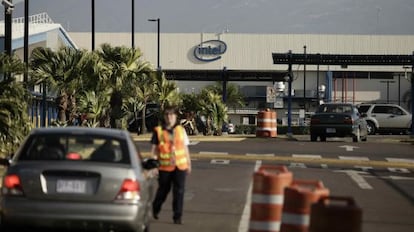Costa Rica emerges as the winner in ‘chip war’ between US and China
The Central American nation is home to Intel’s only assembly and test operations plant in the region at a time when Washington is trying to reduce American reliance on Asia for these essential parts

Intel CEO Pat Gelsinger’s agenda for Tuesday, August 9, indicated that he was supposed to be in Costa Rica to oversee the formal inauguration of the only semiconductor chip assembly and test operations facility that the industry leader has in the West. The event was ultimately held without the top executive, who had a more important date: the signing in Washington DC of a law put in place by the Joe Biden administration to inject $52 billion into the development of this crucial industry in the United States.
The overlapping dates were not entirely a coincidence. Intel has spent the last few years trying to balance out the weight of its operations in Asia, while the Biden administration is promoting local semiconductor production as a key element for the US economy and security in the context of tension with China, in a battle of tech giants that has placed Costa Rica, just a three-hour flight from Miami, in a winning position.
The stars have aligned for the small Central American nation. After Intel moved its manufacturing operations to Asia in 2015, taking away an activity that accounted for 20% of Costa Rican exports, the plant was reactivated again in 2020 with an announced investment of $350 million that ended up growing to $1 billion, including a 60% increase in staff to nearly 4,000 workers in 2022, and even more expansion plans for what may come in the future, said Timothy Scott, Government Relations Manager of Intel Costa Rica, in an interview.
Whatever may come, it is likely to be advantageous for the economy of a country where Intel first established a presence in 1997. “Although [the law signed by Biden] specifically focuses on the United States, due to the geographical proximity and the existing capacities, it could generate an expansive wave,” explained Scott, recognizing the fact that Costa Rica is already home to research and global services centers.
The assembly and testing operations on semiconductors in Costa Rica are a stage in the production chain that comes after the manufacture of silicon wafers, which Intel is developing in Ohio. The latter activity could increase through new investments announced in recent months in other American states as a result of the CHIPS Act, which was passed by Congress in July of this year.
“If the capacity to produce wafers is increased, it stands to reason that the assembly capacity must also be increased, and the closest point for that is Costa Rica,” added Scott, who declined to reveal “for security” reasons the share that Costa Rica represents in the total production of Intel, which controls at least 12% of the world’s semiconductor market. The company’s other manufacturing plants are in Malaysia, Vietnam and the city of Chengdu in southwest China, but restrictions due to the pandemic and disruptions in global logistics have made it more attractive to prioritize short distances.
Meanwhile, the battle for the tiny silicon brains is not letting up. The US government on Friday announced that US companies will be banned from supplying Chinese customers with certain categories of semiconductors made with US technology, in a move that deals a blow to China’s production of weapons and supercomputers. It is the latest escalation in a bilateral battle that accelerated on August 2 with the surprise visit by US House Speaker Nancy Pelosi to Taiwan, the world’s leading semiconductor producer, in a trip viewed by China as a provocation in its own backyard.
Costa Rican officials are viewing every move with caution but also with optimism, said Science and Technology Minister Carlos Enrique Alvarado. Figures handled by the Ministry of Foreign Trade indicate that in 2021 integrated circuits generated $518 million per exported product, or one out of every $20 of the value of total exports. The figures for chips are still lower than in their heyday between 2005 and 2015, but they have been posting a rapid recovery hand in hand with other dynamic sectors such as medical devices, which are currently one of Costa Rica’s leading exports and part of the local technology ecosystem of which Intel was a forerunner.
Tu suscripción se está usando en otro dispositivo
¿Quieres añadir otro usuario a tu suscripción?
Si continúas leyendo en este dispositivo, no se podrá leer en el otro.
FlechaTu suscripción se está usando en otro dispositivo y solo puedes acceder a EL PAÍS desde un dispositivo a la vez.
Si quieres compartir tu cuenta, cambia tu suscripción a la modalidad Premium, así podrás añadir otro usuario. Cada uno accederá con su propia cuenta de email, lo que os permitirá personalizar vuestra experiencia en EL PAÍS.
¿Tienes una suscripción de empresa? Accede aquí para contratar más cuentas.
En el caso de no saber quién está usando tu cuenta, te recomendamos cambiar tu contraseña aquí.
Si decides continuar compartiendo tu cuenta, este mensaje se mostrará en tu dispositivo y en el de la otra persona que está usando tu cuenta de forma indefinida, afectando a tu experiencia de lectura. Puedes consultar aquí los términos y condiciones de la suscripción digital.
More information
Últimas noticias
Maduro pleads not guilty before the federal court in New York: ‘I am still the president of Venezuela’
A new test can detect Alzheimer’s from a finger prick
UN team enters Sudanese city of El Fasher after paramilitary massacre: ‘It’s like a ghost town’
A recipe for resistance: Indigenous peoples politicize their struggles from the kitchen
Most viewed
- Gilles Lipovetsky: ‘If you want to live better and fall in love, take Prozac, don’t look to philosophy’
- Alain Aspect, Nobel laureate in physics: ‘Einstein was so smart that he would have had to recognize quantum entanglement’
- Alvin Hellerstein, a 92-year-old judge appointed by Bill Clinton, to preside over Maduro’s trial in New York
- Why oil has been at the center of Venezuela-US conflicts for decades
- Maduro’s downfall puts China’s relationship with Venezuela to the test










































